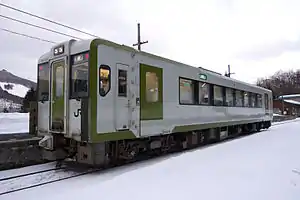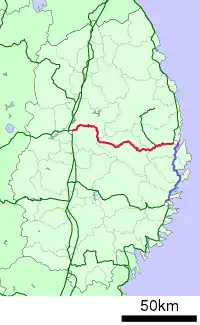Yamada Line (JR East)
The Yamada Line (山田線, Yamada-sen) is a railway line in Japan operated by East Japan Railway Company (JR East). It originally connected Morioka Station in Morioka, Iwate to Miyako Station in Miyako, Iwate. The tracks parallel the Hei River through a mountain valley.
| Yamada Line | |||
|---|---|---|---|
 A KiHa 110 series DMU car on the Yamada Line in March 2012 | |||
| Overview | |||
| Native name | 山田線 | ||
| Status | In operation | ||
| Owner | |||
| Locale | Iwate Prefecture | ||
| Termini | Morioka Miyako | ||
| Stations | 16 | ||
| Service | |||
| Type | Heavy rail | ||
| Operator(s) | JR East | ||
| Rolling stock | KiHa 110 series DMU | ||
| History | |||
| Opened | 10 October 1923 | ||
| Technical | |||
| Line length | 102.1 km (63.4 mi) | ||
| Number of tracks | Entire line single tracked | ||
| Character | Rural | ||
| Track gauge | 1,067 mm (3 ft 6 in) | ||
| Electrification | None | ||
| Operating speed | 85 km/h (53 mph) | ||
| |||
| Route map | ||||||||||||||||||||||||||||||||||||||||||||||||||||||||||||||||||||||||||||||||||||||||||||||||||||||||||||||||||||||||||||||||||||||||||||||||||||||||||||||||||||
|---|---|---|---|---|---|---|---|---|---|---|---|---|---|---|---|---|---|---|---|---|---|---|---|---|---|---|---|---|---|---|---|---|---|---|---|---|---|---|---|---|---|---|---|---|---|---|---|---|---|---|---|---|---|---|---|---|---|---|---|---|---|---|---|---|---|---|---|---|---|---|---|---|---|---|---|---|---|---|---|---|---|---|---|---|---|---|---|---|---|---|---|---|---|---|---|---|---|---|---|---|---|---|---|---|---|---|---|---|---|---|---|---|---|---|---|---|---|---|---|---|---|---|---|---|---|---|---|---|---|---|---|---|---|---|---|---|---|---|---|---|---|---|---|---|---|---|---|---|---|---|---|---|---|---|---|---|---|---|---|---|---|---|---|---|
| ||||||||||||||||||||||||||||||||||||||||||||||||||||||||||||||||||||||||||||||||||||||||||||||||||||||||||||||||||||||||||||||||||||||||||||||||||||||||||||||||||||

Stations
| Station | Japanese | Distance (km) | Rapid Rias | Transfers | Location | |
|---|---|---|---|---|---|---|
| Morioka | 盛岡 | 0.0 | ● |
|
Morioka | Iwate Prefecture |
| Kami-Morioka | 上盛岡 | 2.8 | ● | |||
| Yamagishi | 山岸 | 4.9 | ● | |||
| Kami-Yonai | 上米内 | 9.9 | ● | |||
| Ōshida[Note 1] | 大志田 | 19.2 | | | |||
| Asagishi[Note 1] | 浅岸 | 27.6 | | | |||
| Kuzakai | 区界 | 35.6 | | | Miyako | ||
| Matsukusa | 松草 | 43.6 | | | |||
| Hiratsuto | 平津戸 | 52.2 | | | |||
| Kawauchi | 川内 | 61.5 | | | |||
| Hakoishi | 箱石 | 65.7 | | | |||
| Rikuchū-Kawai | 陸中川井 | 73.5 | ● | |||
| Haratai | 腹帯 | 82.6 | | | |||
| Moichi | 茂市 | 87.0 | ● | |||
| Hikime | 蟇目 | 91.5 | | | |||
| Kebaraichi | 花原市 | 94.2 | | | |||
| Sentoku | 千徳 | 98.8 | ● | |||
| Miyako | 宮古 | 102.1 | ● | Sanriku Railway Rias Line | ||
Footnotes
- Closed in March 2016.
History
The Morioka to Kami-Yonai section opened on 10 October 1923, and the line was opened to Kamaishi in sections between 1928 and 1939.
Freight services ceased between 1984 and 1986.
With the privatization of Japanese National Railways (JNR) on 1 April 1987, the line became part of the JR East network.
The 2011 Tohoku earthquake and tsunami closed the Morioka - Miyako section for one month. The Miyako to Kamaishi section, which parallels the Sanriku-Kaigan area of the Pacific coast, was extensively damaged by the 2011 Tōhoku earthquake and tsunami. Rail service would not resume on this portion of the Yamada Line for a further 8 years. In February 2012, JR East officially proposed that this section of the line be scrapped and the right-of-way used as a bus rapid transit (BRT) route.[1] Ultimately, this decision was reversed in 2015 and the closed section of the line was rebuilt with the aim of then transferring it to Sanriku Railway.[2] This section is scheduled to reopen and transfer the Sanriku Railway to allow its two existing segments, the Kita-Rias Line and Minami-Rias Line, to be connected on reopening in 2019.[3]
On 23 March 2019, the Miyako to Kamaishi section reopened and was transferred to the Sanriku Railway.[4]
Ōshida and Asagishi stations were closed from January until 15 March 2013 due to low utilization during the winter months.[5] The two stations closed following the last day of services on 25 March 2016.[6]
See also
References
- 被災2路線、廃止しバス専用道提案へ JR東、岩手県に [JR East proposes to scrap two lines and convert to bus routes]. The Asahi Shimbun Digital (in Japanese). Japan: The Asahi Shimbun Company. 8 February 2012. Retrieved 11 March 2012.
- http://www.yomiuri.co.jp/national/20150307-OYT1T50115.html?from=ytop_main5. Missing or empty
|title=(help) - "Sanriku Railway approaches major turning point on railroad to recovery". The Japan Times Online. 6 April 2018.
- 東日本大震災 復興鉄路つながった 8年ぶり宮古-釜石、三陸鉄道に [Great East Japan Earthquake Railway have been rebuilt and connected after 8 years reconstruction between Miyako-Kamaishi, Sanriku Railway]. mainichi.jp (in Japanese). Japan: The Mainichi Newspapers Co., Ltd. 23 March 2019. Retrieved 24 March 2019.
- 奥羽・山田線駅を冬季休止へ [Ou & Yamada Line stations to be closed during winter season]. Japan Railfan Magazine. Vol. 53 no. 622. Japan: Koyusha Co., Ltd. February 2013. p. 163.
- 災害による鉄道運休、震災前の被災区間が全て解消…3月末 [Suspended rail lines - All lines closed before earthquake to be reopened by end of March]. Response (in Japanese). Japan: IID Inc. 1 April 2016. Retrieved 5 May 2016.

.svg.png.webp)